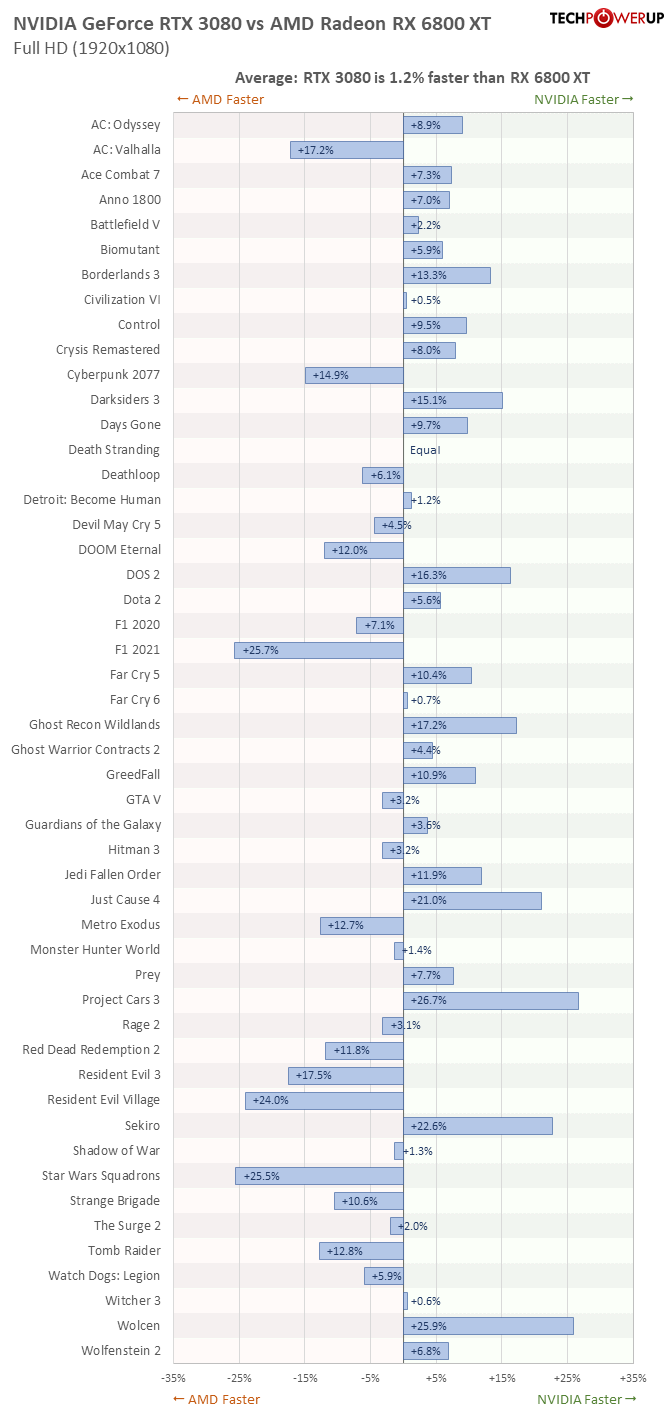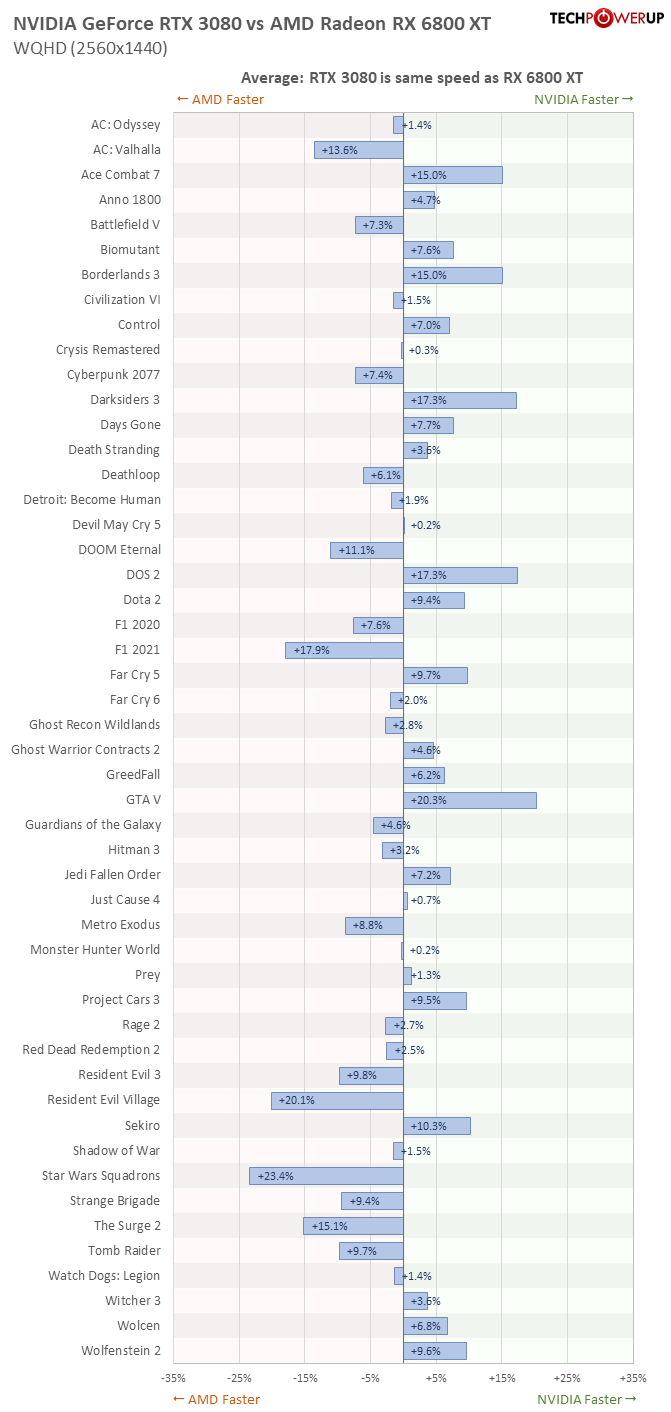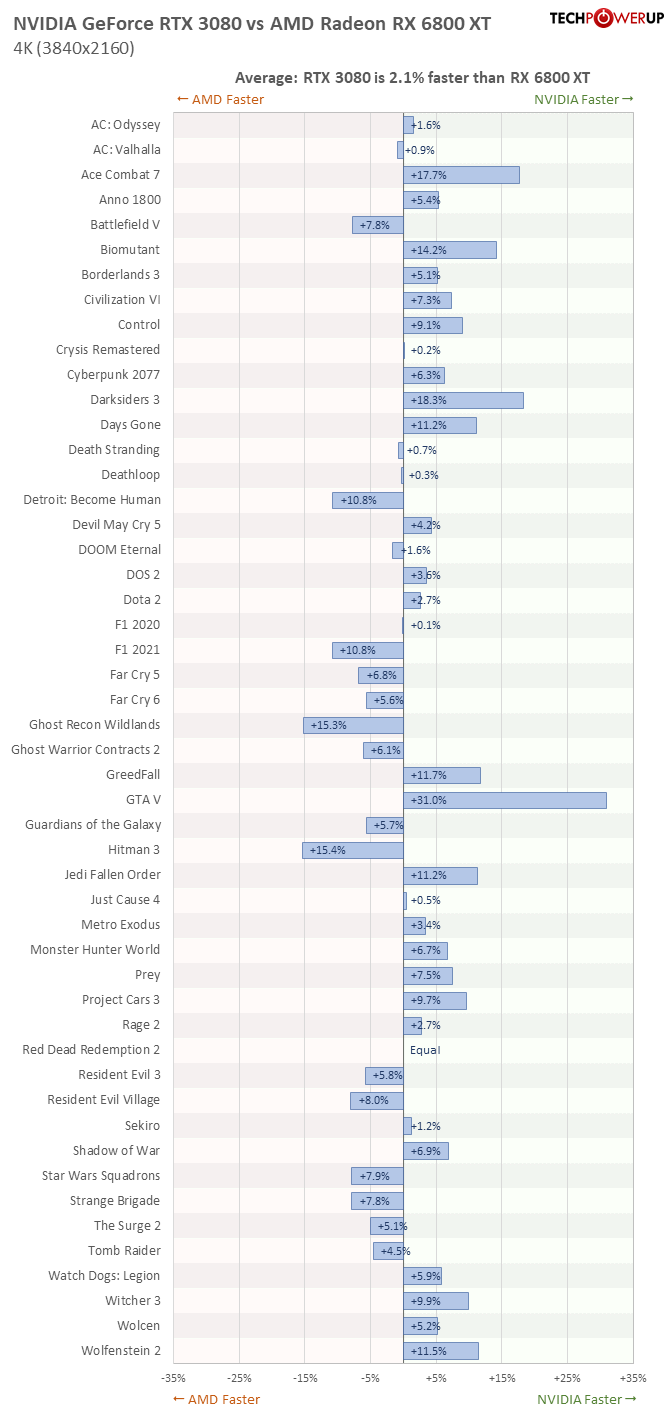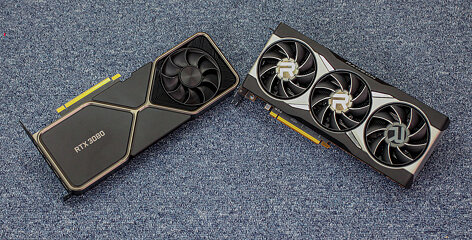 122
122
50 Games Tested: GeForce RTX 3080 vs. Radeon RX 6800 XT
(122 Comments) »Introduction
Welcome to a new regular feature we're doing here at TechPowerUp, the TPU50. This is a compilation of graphics card performance on a gargantuan set of 50 games from recent years, based on contemporary game engines and 3D graphics APIs. Each of the 50 titles is tested across three of the most popular display resolutions: Full HD (1920x1080 pixels), WQHD (2560x1440 pixels), and 4K Ultra HD (3840x2160 pixels).
TPU50 benchmarks two graphics cards of a similar price category to help you figure out which one better suits your needs, or simply is the better buy. While the focus is on raw performance for this series, we will also touch on things like power, heat, noise, availability, etc., in the conclusion. For today's article, we've chosen to benchmark NVIDIA's GeForce RTX 3080 against AMD's Radeon RX 6800 XT using recently released drivers from October. Since this is a duel between two cards, our data is presented as an easy-to-read percentage difference.
For all intents and purposes, the cards we're testing today are posterboys of their respective architectures. The NVIDIA GeForce RTX 3080 was launched as the "flagship" gaming graphics product based on the "Ampere" graphics architecture despite RTX 3090 launching at the same time. This was because the RTX 3080 presented such a massive performance uplift over the RTX 2080 that it was the first card to play any of today's games at 4K Ultra HD resolution, and the RTX 3090 was much more expensive partly due to its 24 GB VRAM, which provides no significant benefit to gamers today.
The Radeon RX 6800 XT, which was released in November 2020, just two months after the RTX 3080, came as a surprise to everyone in the tech space. AMD's card led the company's return to the high-end graphics space after nearly seven years. The company had been written off by many, and we heard phrases like "how can AMD catch up to NVIDIA ever again?". AMD's RDNA 2 architecture not only came with unbelievable efficiency improvements, it also introduced real-time ray tracing support and offered a massive performance uplift over the previous-generation RX 5700 XT.
Benchmarks
Among our games, you'll find titles that have been included in TechPowerUp graphics card reviews over the past years, as well as some of the newer ones joining our bench soon. Going forward, we will of course make changes to the game selection for TPU50. Our goal is to have a rich diversity of game genres, engines, and 3D graphics APIs. Equal settings were used for both cards, and proprietary features disabled.All games are tested in custom bench scenes as the integrated benchmarks often paint a completely inaccurate picture compared to actual gameplay. Also, the GPU vendors actively optimize their drivers to achieve good results in integrated benchmarks.
| Title | Released | API | Engine |
|---|---|---|---|
| Ace Combat 7 | 2019 | DX11 | UE4 |
| Anno 1800 | 2019 | DX12 | Anno |
| Assassin's Creed Odyssey | 2018 | DX11 | Anvil Next 2.0 |
| Assassin's Creed Valhalla | 2020 | DX12 | Anvil Next 2.0 |
| Battlefield V | 2018 | DX11 | Frostbite |
| Biomutant | 2021 | DX11 | UE4 |
| Borderlands 3 | 2019 | DX11 | UE4 |
| Civilization VI | 2016 | DX12 | Civilization |
| Control | 2019 | DX12 | Northlight |
| Crysis Remastered | 2020 | DX11 | CryEngine 5.6 |
| Cyberpunk 2077 | 2020 | DX12 | REDEngine |
| Darksiders 3 | 2018 | DX11 | UE4 |
| Days Gone | 2021 | DX12 | UE4 |
| Death Stranding | 2020 | DX12 | Decima |
| Deathloop | 2021 | DX12 | Void |
| Detroit: Become Human | 2019 | Vulkan | Quantic Dream |
| Devil May Cry 5 | 2019 | DX11 | RE |
| Divinity Original Sin 2 | 2017 | DX11 | Divinity |
| DOOM Eternal | 2020 | Vulkan | id Tech 7 |
| Dota 2 | 2016 | DX11 | Source 2 |
| F1 2020 | 2020 | DX12 | EGO 3.0 |
| F1 2021 | 2021 | DX12 | EGO 4.0 |
| Far Cry 5 | 2018 | DX11 | Dunia |
| Far Cry 6 | 2021 | DX12 | Dunia |
| Ghost Recon Wildlands | 2017 | DX11 | Anvil Next 2.0 |
| Ghost Warrior Contracts 2 | 2021 | DX11 | CryEngine 3 |
| GreedFall | 2019 | DX11 | Silk |
| Grand Theft Auto V | 2013 | DX11 | Rockstar Adv. |
| Guardians of the Galaxy | 2021 | DX12 | Dawn |
| Hitman 3 | 2021 | DX12 | Glacier |
| Jedi Fallen Order | 2019 | DX11 | UE4 |
| Just Cause 4 | 2018 | DX11 | Apex |
| Metro Exodus | 2019 | DX12 | 4A |
| Monster Hunter World | 2018 | DX11 | MT Framework |
| Prey | 2017 | DX11 | CryEngine |
| Project Cars 3 | 2020 | DX11 | Madness |
| Rage 2 | 2019 | Vulkan | Avalance |
| Red Dead Redemption 2 | 2019 | Vulkan | Rockstar Adv. |
| Resident Evil 3 | 2020 | DX12 | RE |
| Resident Evil Village | 2021 | DX12 | RE |
| Sekiro | 2019 | DX11 | Souls |
| Shadow of War | 2017 | DX11 | LithTech |
| Shadow of the Tomb Raider | 2018 | DX12 | Foundation |
| Star Wars Squadrons | 2020 | DX11 | Frostbite |
| Strange Brigade | 2018 | DX12 | Asura |
| The Surge 2 | 2019 | Vulkan | Fledge |
| Watch Dogs: Legion | 2020 | DX12 | Dunia |
| Witcher 3 | 2015 | DX11 | REDEngine |
| Wolcen | 2020 | DX11 | CryEngine3 |
| Wolfenstein 2 | 2017 | Vulkan | id Tech 6 |
Test System
| Test System | |
|---|---|
| Processor: | AMD Ryzen 7 5800X, PBO Max Enabled (Zen 3, 32 MB Cache) |
| Motherboard: | EVGA X570 Dark BIOS 1.03 |
| Resizable BAR: | Enabled on all supported AMD & NVIDIA cards |
| Memory: | Thermaltake TOUGHRAM, 16 GB DDR4 @ 4000 MHz 20-23-23-42 1T Infinity Fabric @ 2000 MHz (1:1) |
| Cooling: | Cooler Master MasterLiquid ML240L V2 240 mm AIO |
| Thermal Paste: | Arctic MX-5 |
| Storage: | 2x Neo Forza NFP065 2 TB M.2 NVMe SSD |
| Power Supply: | Seasonic Prime Ultra Titanium 850 W |
| Case: | darkFlash DLZ31 Mesh |
| Operating System: | Windows 10 Professional 64-bit Version 21H1 (May 2021 Update) |
| Drivers: | AMD: 21.10.3 Beta NVIDIA: 496.49 WHQL |
Benchmark Results
First, we'll give you an overview of all fifty games, tested in three resolutions: 1920x1080 (Full HD), 2560x1440 (WQHD), and 3840x2160 (4K).


DirectX 12 and Vulkan Games Only

DirectX 11 Games Only

Games Released 2018 and Before

Games Released 2019

Games Released 2020

Games Released 2021

Conclusion
As you can imagine, doing all the testing required for this article was a massive undertaking—benchmarking 50 games at three resolutions takes a lot of time. We're talking about 150 benchmark runs per card here, 300 in total, just for this article. At a couple of minutes per benchmark run, I'm sure you can do the math of how long it takes. Processing all the numbers was also more work than expected, but I feel like we've gained some pretty good insights here.In our launch day review, the Radeon RX 6800 XT was 6% behind the GeForce RTX 3080 at 4K resolution (launch review). At 1440p, the difference was 4%, and 6% at Full HD. A lot has changed since then. We've upgraded our test system from Core i9-9900K to Ryzen 7 5800X, both AMD and NVIDIA have enabled PCI-Express Resizable BAR in their drivers, and drivers of course had time to mature.
Today, the performance difference has shrunk to 2.1% at 4K, 0% at 1440p, and 1.2% at Full HD. This means NVIDIA's GeForce RTX 3080 is still faster than the Radeon RX 6800 XT, but AMD has caught up a lot, and the average difference is small enough that I'd say both cards can be considered equal in terms of performance. Of course, even though we tested 50 games, or maybe because we tested so many games, the performance in specific titles will vary big time. For example, if you play Battlefield V all day, the RX 6800 XT will give you higher framerates. On the other hand, if the games you play are mostly older releases using the DirectX 11 API, NVIDIA will be ahead. That's exactly why I tried to break out specific scenarios, like "DX12 and Vulkan Games Only" or "Games released 2020."
The biggest surprise for me is that there seems to be a very clear trend showing that AMD's Radeon is running better and better in new releases. I'm not sure about the exact reason. Maybe it's because the new game consoles are based on AMD hardware? The last generation of consoles used AMD, too, so that's probably not it. What seems to be real though is that AMD developer relations are more active, probably with more staff, resources, and money. While AMD did regularly miss the ball on day zero driver support several years ago, important game releases are now almost guaranteed to have an AMD game-ready driver available on launch—something NVIDIA has been providing for more than a decade. Many of you will remember driver issues on AMD, like all the problems people had with the Radeon RX 5700 XT. These seem to be a thing of the past, too, so good job, AMD.
I also feel AMD's marketing is getting more aggressive in locking in relationships with game studios, which no doubt is helped by AMD having more funds available for such projects thanks to the company's general success. While I'm not aware of any claims that NVIDIA has been focusing less on their game developer relations, it is still a possibility—over the years, NVIDIA has transformed into a huge company that has sources of revenue that go well beyond gaming. I can certainly imagine that accountants will question all investments in a market where you can easily sell everything you create.
While all our benchmarks are tested with ray tracing disabled and only few games today support the technology, ray tracing is here to stay. Comparing the Radeon RX 6800 XT with the RTX 3080 makes that NVIDIA has the upper hand in ray tracing performance crystal clear. The differences are significant, and if you believe ray tracing is the future, you should definitely consider the RTX 3080. On the other hand, some recent video game releases only have minimal ray tracing support that's just good enough to tick the "i haz ray tracing" checkbox without achieving the stunning fidelity improvements we were promised. In those titles, the RT performance hit is minimal, and both cards are surprisingly similar in FPS.
When the GeForce RTX 3080 released with 10 GB VRAM I was convinced it would be sufficient for the lifetime of the card. Recently, we have for the first time seen titles reach that amount at the highest settings in 4K, but only with ray tracing enabled. Examples of that are DOOM Eternal and Far Cry 6. While this shouldn't be a deal breaker, it's still something worth mentioning. AMD's RX 6800 XT does have 16 GB VRAM, which provides a small advantage here. With DirectStorage around the corner, memory requirements of games might actually go down because assets can be streamed in from the disk in a much more efficient manner.
Last but not least, another consideration worth making is power, heat, and noise. Here, AMD has the upper hand thanks to TSMC's 7 nanometer production process, while NVIDIA uses Samsung's 8 nanometer node, which is a bit less energy efficient. PSU requirements are not that different, though; during gaming, 320 W for the RTX 3080 Founders Edition and 290 W for the Radeon RX 6800 XT Reference. Of course, 30 W are 10%, but I don't feel like this should be a major factor in your buying decision. In terms of custom board designs, the selection for NVIDIA (177 models) is much bigger than for AMD (34 models) partly because NVIDIA is now shipping "low-hashrate" versions that are considered separate SKUs. At the end of the day, it doesn't matter as long as you can find a decent card with good performance and low noise levels.
The biggest issue today for both the Radeon RX 6800 XT and GeForce RTX 3080 is their terrible availability. They are sold out pretty much everywhere, and either MSRP (RTX 3080 $700, RX 6800 XT $650) will make people LOL or cry depending on whether they have such a card in their PC or are trying to buy one. At $1500 for the GeForce RTX 3080 and $1450 for the Radeon RX 6800 XT under current market conditions, both are basically identically priced. I guess it at the moment comes down to what you can find, especially if one is more reasonably priced than the other—both cards will give you outstanding performance at 4K.
Since this is is a new format, please do let us know your thoughts in the comments, including what you'd like to see improved.
Jul 14th, 2025 16:00 CDT
change timezone
Latest GPU Drivers
New Forum Posts
- AAF Optimus Modded Driver For Windows 10 & Windows 11 - Only for Realtek HDAUDIO Chips (578)
- i7 2860QM how to raise power limit? (21)
- AMD 7Ghz? This keeps popping up on my feeds! (6)
- Stupid things one has done with hardware (49)
- No offense, here are some things that bother me about your understanding of fans. (111)
- Choosing the right motherboard (5)
- Best motherboards for XP gaming (151)
- Which CPU to Choose for a 7900 XT? Ryzen 7 7700 or Ryzen 5 9600X? (43)
- Bent pins on an AM5 mobo, any way to test them and also find which ones were on the schematic? (6)
- Arc 770a 16gb money pit (9)
Popular Reviews
- Lexar NM1090 Pro 4 TB Review
- Our Visit to the Hunter Super Computer
- MSI GeForce RTX 5060 Gaming OC Review
- Fractal Design Epoch RGB TG Review
- NVIDIA GeForce RTX 5050 8 GB Review
- Corsair FRAME 5000D RS Review
- Sapphire Radeon RX 9060 XT Pulse OC 16 GB Review - An Excellent Choice
- Chieftec Iceberg 360 Review
- AMD Ryzen 7 9800X3D Review - The Best Gaming Processor
- Upcoming Hardware Launches 2025 (Updated May 2025)
TPU on YouTube
Controversial News Posts
- Intel's Core Ultra 7 265K and 265KF CPUs Dip Below $250 (288)
- Some Intel Nova Lake CPUs Rumored to Challenge AMD's 3D V-Cache in Desktop Gaming (140)
- AMD Radeon RX 9070 XT Gains 9% Performance at 1440p with Latest Driver, Beats RTX 5070 Ti (131)
- NVIDIA Launches GeForce RTX 5050 for Desktops and Laptops, Starts at $249 (122)
- NVIDIA GeForce RTX 5080 SUPER Could Feature 24 GB Memory, Increased Power Limits (115)
- Microsoft Partners with AMD for Next-gen Xbox Hardware (105)
- Intel "Nova Lake‑S" Series: Seven SKUs, Up to 52 Cores and 150 W TDP (100)
- NVIDIA DLSS Transformer Cuts VRAM Usage by 20% (97)
